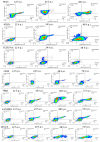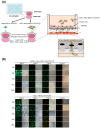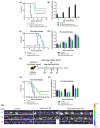Adipose-Derived Stem Cells as Carrier of Pro-Apoptotic Oncolytic Myxoma Virus: To Cross the Blood-Brain Barrier and Treat Murine Glioma
- PMID: 39457007
- PMCID: PMC11508294
- DOI: 10.3390/ijms252011225
Adipose-Derived Stem Cells as Carrier of Pro-Apoptotic Oncolytic Myxoma Virus: To Cross the Blood-Brain Barrier and Treat Murine Glioma
Abstract
Treatment of glioblastoma is ineffective. Myx-M011L-KO/EGFP, a myxoma virus actively inducing apoptosis in BTICs linked to recurrence, offers innovative treatment. We loaded this construct into adipose-derived stem cells (ADSCs) to mitigate antiviral host responses and enable systemic delivery. The apoptotic and cytotoxic effects of the construct were studied using murine and human glioblastoma cell lines. Before implementing systemic delivery, we delivered the construct locally using ADSC to verify elimination of orthotopic murine glioma lesions. vMyx-M011L-KO/EGFP was cytotoxic to a murine cell line, preventing effective virus multiplication. In three human glioma cell lines, viral replication did occur, coupled with cell killing. The knock-out construct induced apoptotic cell death in these cultures. ADSCs infected ex vivo were shown to be sufficiently migratory to assure transfer of the therapeutic cargo to murine glioma lesions. Virus-loaded ADSCs applied to the artificial blood-brain barrier (BBB) yielded viral infection of glioma cells grown distally in the wells. Two rounds of local administration of this therapeutic platform starting 6 days post tumor implantation slowed down growth of orthotopic lesions and improved survival (total recovery < 20%). ADSCs infected ex vivo with vMyx-M011L-KO/EGFP show promise as a therapeutic tool in systemic elimination of glioma lesions.
Keywords: adipose tissue-derived stem cells (ADSCs); blood–brain barrier; glioblastoma; myxoma virus; oncolytic virotherapy.
Conflict of interest statement
The authors declare no conflicts of interest.
Figures





Similar articles
-
Adipose-derived stem cells as therapeutic delivery vehicles of an oncolytic virus for glioblastoma.Mol Ther. 2010 Feb;18(2):377-85. doi: 10.1038/mt.2009.265. Epub 2009 Nov 10. Mol Ther. 2010. PMID: 19904233 Free PMC article.
-
M011L-deficient oncolytic myxoma virus induces apoptosis in brain tumor-initiating cells and enhances survival in a novel immunocompetent mouse model of glioblastoma.Neuro Oncol. 2016 Aug;18(8):1088-1098. doi: 10.1093/neuonc/now006. Epub 2016 Mar 8. Neuro Oncol. 2016. PMID: 26962017 Free PMC article.
-
In vitro screen of a small molecule inhibitor drug library identifies multiple compounds that synergize with oncolytic myxoma virus against human brain tumor-initiating cells.Neuro Oncol. 2015 Aug;17(8):1086-94. doi: 10.1093/neuonc/nou359. Epub 2015 Jan 20. Neuro Oncol. 2015. PMID: 25605818 Free PMC article.
-
[Oncolytic viruses for therapy of malignant glioma].Biomed Khim. 2016 May;62(4):376-90. doi: 10.18097/PBMC20166204376. Biomed Khim. 2016. PMID: 27562991 Review. Russian.
-
Oncolytic Virotherapy in Glioma Tumors.Int J Mol Sci. 2020 Oct 14;21(20):7604. doi: 10.3390/ijms21207604. Int J Mol Sci. 2020. PMID: 33066689 Free PMC article. Review.
Cited by
-
Cell Carriers for Oncolytic Virus Delivery: Prospects for Systemic Administration.Cancers (Basel). 2025 Jul 10;17(14):2296. doi: 10.3390/cancers17142296. Cancers (Basel). 2025. PMID: 40723180 Free PMC article. Review.
-
Optimizing Oncolytic Virotherapy for Malignant Glioma: From Bench to Bedside.Cancer Manag Res. 2025 Aug 4;17:1537-1554. doi: 10.2147/CMAR.S528875. eCollection 2025. Cancer Manag Res. 2025. PMID: 40786912 Free PMC article. Review.
References
-
- Pisklakova A., McKenzie B., Zemp F., Lun X., Kenchappa R.S., Etame A.B., Rahman M.M., Reilly K., Pilon-Thomas S., McFadden G., et al. M011L-deficient oncolytic myxoma virus induces apoptosis in brain tumor-initiating cells and enhances survival in a novel immunocompetent mouse model of glioblastoma. Neuro-Oncol. 2016;8:1088–1098. doi: 10.1093/neuonc/now006. - DOI - PMC - PubMed
MeSH terms
Grants and funding
LinkOut - more resources
Full Text Sources
Research Materials

